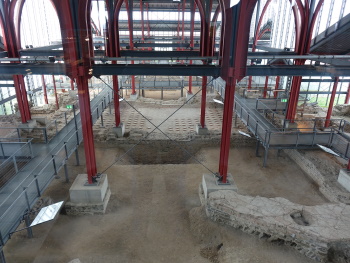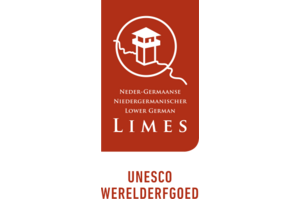Lower German Limes

The Lower German Limes formed the north-eastern border of the Roman province Germania Inferior along the Rhine between the North Sea coast in the Netherlands and the Rhine south of Bonn where the Upper Germanic-Rhaetian Limes starts.
They include the traces of military fortifications, roads, settlements, an aqueduct and canals, often now buried in wetland. The long linear frontier made the Roman army adapt to the use of smaller military installations instead of big operational bases. The frontier was far from impregnable and allowed for trade and cultural exchange.
Community Perspective: Most of the structures only have been preserved underground. Original remains are visible at the Archaeological Park Xanten (“Roman Disneyland”: “It's a bit strange to reconstruct a temple as a ruin, isn't it?”), the Haus Bürgel in Monheim, the Cologne Praetorium, and in Iversheim. In the Netherlands, you can visit some remains under the Dom Square in Utrecht.




Map of Lower German Limes
Community Reviews
Digits

We visited the Köln-Deutz component on a sunny hot September day in 2023 as the Praetorium was (and still is) closed for visitors. A 20 minute walk from Cologne Cathedral across the Hohenzollernbrucke to the eastern bank of the Rhine allows for excellent views of the modern-day cathedral but in Roman times would have had line of sight to the provincial governors palace at the Praetorium. You will have the (admittedly few) remains all to yourself as visitors instead throng the riverfront or city centre. An unexciting 10-15 minutes is the extent of the visit to what are some 1970s reconstructed outlines (using original stones) of one of the gates of the Divittia bridgehead fort, its location in a quiet pedestrian throughway a far cry from being an essential part of Emperor Constantine’s late Roman era defensive line.
There is an information board onsite (fully in German if I recall) and a bronze model up some steps that we missed. Far more is actually to be gleaned from the nomination and ICOMOS documents which identifies Köln-Deutz as one of the few components to actually have some above-ground features as well as the only permanent military installation of the Lower German Limes on the right bank of the Rhine, connected by a 400m bridge to the colony that is now Cologne. Forts of the Late Roman period are characterised by heavy stone walls and large numbers of round towers, of which Köln-Deutz is the best preserved example and seemingly a blueprint for other such forts. Divitia, with its 18 projecting rounded towers, is also one of the few examples of a Late Roman fort where the interior layout of barracks, roads and sewers catering to 1,000 soliders is fully understood. Built around 309AD, when Köln was taken over by the Franks in the 450s AD, Roman rule of the Lower Rhine area finally ceased.
The remains of the western gate are now hidden under the ‘Rheinboulevard’. The nomination file rates this component (out of 3) as 1 for wholeness, 2 for intactness, 3 for form and design, 2 for materials and substance and 3 for location and setting. I love the Romans, but can’t help feel that doesn’t quite tally with my own rating scale!
Tony H.

I visited in April 2024 the DOMunder experience in Utrecht. Like previous reviewer has explained, you get to go under the Domplein square to explore with flashlights the ruins of the Dom Church's nave that was destroyed by a tornado(!) in 1647. However, besides the church ruins you can see also other ruins from different time periods, one of them being the Roman period. There is a very tiny part of the Roman wall on show as the Roman ruins are not the main focus of the DOMunder.
The DOMunder tour started with a presentation in the basement of Utrecht Music School where the guide goes through also the Roman history of the Domplein. And here you can get really close to the actual Roman wall ruins! Before the presentation started our guide showed us a hole in the wall where you can see and touch the original Roman wall. This is not automatically part of the tour so you can ask from your guide to see it in case they forget to show it. I really enjoyed the DOMunder experience and can recommend it for anyone interested in history.
I booked the tour online and checked in for it at the Utrecht tourist information center. From the tourist info I got myself a free brochure about the Lower German Limes sites around Utrecht. They all seem to be worth of visit if you're interested in Roman history but the DOMunder is the only way to see the original ruins in Utrecht. Around the Domplein, metal plaques mark where the walls of the Roman fortress once ran (or still run underground, pictured).
Philipp Peterer

I visited the Lower German Limes in Germany and the Netherlands. The “Roman Disneyland” Xanten is already covered in other reviews. The museum in Cologne was in September still under reconstruction. Therefore I will focus my review on the Netherlands.
In my quest to find original remains in the Netherland. While most of the dots on our map seem to scatter around Nijmegen, it seems that none of these remains are actually visible. Then I stumbled upon Utrecht. Most (if not all) remains in the Netherlands are underground and in Utrecht you have the chance to go there. "DOM under" provides a guided tour to, you guessed it, an excavation site under the cathedral, or rather the part of the main square, that used to be part of the cathedral before a storm struck it down.
Space down there is limited. So you need to pre-book for a timeslot. We started in the basement of a house. There are a few exhibition items and the briefing took place there. Most important: there are remains of the roman walls visible within the building structure. For the second part, we left the building and entered the excavation site via stairs in the middle of the square. The Roman remains are only part of what I saw underground. There are several layers with part of the earliest church and the destroyed cathedral as well. However, there are Roman remains, which makes the Limes in the Netherlands not completely invisible.
The tour is fun. You will get a special flashlight/audioguide and can explore the (small) site on your own. Further, there are several movies to tell you the story of Utrecht. The guide was also very helpful. They seem to do this voluntarily and most ticket money goes into further excavations.
Be aware that Utrecht is not a very car friendly town. Parking is very expensive and getting in and out the city center takes some time.
You can easily combine this visit with the Rietveld-Schröder house. There are also a few forts of the defense line nearby. I combined the visit with
Clyde

I visited the Lower German Limes WHS location of Remagen in Germany in October 2021 which was one of the only open sites during the pandemic. Basically this WHS is all about scattered Roman remains or ruins so I wasn't expecting much, even though it has to be said that Remagen has a good network of several types of Roman remains or ruins which make for a pleasant loop near the Rhine with 15 stops named Stadtrundgang with information boards in English and German at each stop. The Roman Museum only has information boards in German, but English translations are provided at the entrance.
The "highlight" of this location is the Roman Museum of Remagen with exhibits from the old Roman fort of Rigomagus displayed in the former chapel of St. Magdalena from the 15th century. The collection includes coins and grave contents from the 1st to the 4th centuries AD. Some tombstones with figures of Roman soldiers in full gear are noteworthy. The finds provide an insight into the life of the Roman soldiers based on the Rhine. In the basement of the former chapel you can visit the foundations of an arcade/portico from the 2nd century with 3 large column bases. This portico was the entrance to the "principia", the headquarters of a Roman fort.
The ancient author Ammianus Marcellinus mentions Remagen in his report on the invasion of the Franks in 356. The Roman army under Emperor Julian found the forts and towns between Koblenz and Cologne destroyed by the Germans except the "Rigomagum oppidum" and a tower near Cologne. On the "Tabula Peutingeriana" which is a copy of a Roman road map from the 4th century you can find "Rigomagus" between Bonn and Andernach.
When most people hear the word "Limes" today, the ditch and ramparts built by Roman soldiers between the Rhine and the Danube. This line was 300 miles long and consisted of a road, forts, watchtowers, ditch and ramparts, and a palisade or wall. This frontier was given up by the Roman army around 260 AD. In Lower Germany, the Limes or frontier was the Rhine. From the North Sea to Remagen which was the last fort in Lower Germany where about 35,000 to 42,000 Roman soldiers were stationed in the 1st century AD; in the 2nd and 3rd centuries there were 20,000 to 27,000 soldiers. Half of them were auxiliaries.
The Roman Museum is free of charge and opens March till end October Wednesday to Sunday 15:00-17:00 (closed on Mondays and Tuesdays). The museum forms part of what is known as the "historical triangle". Here the Roman fort Rigomagus stood from the 1st to the 4th centuries. Apart from the museum, preserved remains of the late Roman fortification wall, the Praetorium and the Principia can be visited also in the cellar of the former youth centre. The main advantage of going on a guided city tour of Remagen is that it is the only way to be able to visit the Roman hypocaust heater beneath the former youth centre of Remagen.
All in all a pleasant day trip visit to yet another Ancient Roman WHS but certainly not one of the most deserving not only on a national level but especially on a global level.
Hubert

The nomination of the Lower German Limes is scheduled for 2021. The German part of this TWHS includes 25 components, some of which have multiple locations. However, not much is left of the Limes section along the Lower Rhine today, only very few original remains are visible, most remains have been preserved underground. Hence it seems more than questionable whether the Lower German Limes could add anything significant to the already inscribed parts of the Frontiers of the Roman Empire.
The Dutch nomination website provides the entire nomination dossier including maps. Based on this information, I have identified the following locations of the German part, where original remains are visible:
- Xanten Colonia Ulpia Traiana (CUT) (id 27), an archaeological park
- Monheim Haus Bürgel (id 35), remains of the original walls are visible in walls of the later medieval and modern estate
- Cologne Praetorium (id 37), the former Palace of the Roman govenor; remains are shown in an underground museum
- Iversheim (id 43), remains of six lime kilns
I visited Xanten and Iversheim in summer 2020. The Praetorium in Cologne was closed due to construction works (until 2021), the area is being redesigned into an archaeological zone. And the Haus Bürgel didn’t seem worth the detour.
Xanten was once one of the largest and most important Roman settlements in the Germanic provinces. The archaeological park encompasses the boundaries of the historic Colonia Ulpia Traiana. It is a large but almost empty area. Near the main entrance, some buildings have been reconstructed: the city wall, an amphitheater, a Roman hostel and craftsmen's houses, as well as the ruins of an harbour temple (it's a bit strange to reconstruct a temple as a ruin, isn't it?). These reconstructions certainly serve their purpose of illustrating life in Roman times, but for a WH enthusiast only the original stuff counts, of course. And that is rather sparse in Xanten: a few excavated foundation walls and remnants of sewers and water pipes in the outdoor area. And most importantly, the foundations of the vestibule of the Great Baths, which can be visited in the basement of the Roman Museum. The museum isn't bad, but it displays more or less the same items as other Roman museums. In recent years I have visited quite a few of these local museums along the German Limes, so that I am no longer very enthusiastic about them.
The lime kilns in Iversheim were more interesting, although I wouldn't say the site is overwhelming or a must-see. The kilns are remains of an early industrial facility, operated by the Romans to produce quicklime from local dolomite. Quicklime is a major component of mortar, which was required in large quantities for stone buildings. The site is rather small: six kilns in a row, each about 3 meters in diameter (photo). Four kilns are covered by a protective building, a fifth kiln has been reconstructed and put into operation in order to recreate the burning process as it was in Roman times; the last one is not visible.
The site has limited opening hours, from May to October on weekends and public holidays. I spent a bit more time there than actually required for a proper visit. I had a nice conversation with two volunteers from the local historical association that runs the site. So far they rely on donations, but hopefully after inscription they will receive more support from the administrative authorities to further maintain the site and extend the opening hours.
Els Slots

Frontiers of the Roman Empire - Lower German Limes, together with the Dutch Limes TWHS, is scheduled to be nominated in 2021. Together they form the 3rd of 4 clusters of separate stretches of the Roman frontiers up for inclusion, after the already inscribed UK/German one plus the ‘western Danube Limes’ (2019) and before the ‘eastern Danube Limes’ (2022). The Lower German Limes is concentrated along the river Rhine, which acted as a natural border of the Roman province of Germania Inferior.
I had ‘been’ to its Dutch counterpart already in 2011, which was a very underwhelming experience. Both Lower German parts together are said to comprise 55 locations. Among the locations in Germany, it’s hard to say which stand out so much that they warrant a visit. I choose Xanten, which is home to 4 of the locations ánd has a well-developed archaeological park plus Roman museum within its borders.
Xanten is a mid-sized town just across the Dutch/German border near Nijmegen. In Roman times it was the site of the Roman city of Colonia Ulpia Traiana. The proposed locations include a road, a defensive structure, the late Roman fortress Tricensima and the legionary fortress Vetera. The tentative site description at the UNESCO website puts them somewhere off the coast of Somalia, but by turning the coordinates around I could trace them back to modern day Xanten. At least Tricensima is part of the Roman archaeological park, the others may be slightly outside.
The Xanten Archaeological Park is a large, open area where various buildings have been rebuilt in their original dimensions at exactly the same location as the former Roman colony. They include the city wall with guard posts, an amphitheatre, an inn and a temple. The amphitheatre has been fully re-erected, but the Harbour Temple has been reconstructed as a ruin. That is of course a bit odd if you try to imitate a city in Roman times: at that time it was of course intact and probably a colourful affair. And there is more that is missing: between these large 'monuments' lie neat green lawns. But this was a city with 10,000 inhabitants in Antiquity, so where have all the houses and shops gone?
At the far end of the park stands a large, modern building made of iron and glass: this is the reconstructed entrance hall to the Roman baths. It now houses the Roman Museum. Spread over a number of floors, it exhibits Roman findings from Xanten. Xanten has long been an important military site, so it is not surprising that army helmets, spears and swords play a prominent role in the exhibition. You can also see the reconstructed ancient Roman baths from the higher floors of the museum - this was the largest public building of the Roman city. Outside lie some stone blocks that originate from the Roman buildings, but were used in the Middle Ages to build the 'modern' city of Xanten. Some underground sewers have also been excavated.
Among things Roman, this is really a minor site. While I already expressed doubts about giving WH status to Nimes, I’d rate this at yet another level lower. Nimes at least has 2 major monuments left from Antiquity; Xanten only has a sewage system and some foundations! Nimes and Xanten are also comparable as they both were provincial Roman colonies of about 10,000 – 20,000 inhabitants. And both have recently constructed museums about life in Roman times which are quite similar in value.
Read more from Els Slots here.
Els Slots

The Dutch T-List nomination for an extension of the Frontiers of the Roman Empire has come as a surprise to me:
a. The Advisory Committee had concluded in 2010 that there was no coordination between the provinces and cities along the former Roman frontier line in the Netherlands on this subject. So there was insufficient steering and power behind a possible nomination.
b. There is nothing left to see!
The Romans arrived around 15 B.C. in what is now The Netherlands, and stayed intermittently for some 300 years. They constructed a number of fortifications along the Rhine river. Roman objects have been found in the moist ground along the river, and sometimes they even have been fished from the water.
The Roman remains in the Netherlands have the obscurity of the Pile Dwellings in the Alps or the Struve Geodetic Arc. Except for a single stone or two, there's nothing to warrant a visit. Museum Het Valkhof in Nijmegen probably is the best option to get a feel of what impact the Romans had on the Netherlands. In October 2011 I spent about an hour there, enjoying the sometimes surprisingly precious objects. The photo attached for example is a decorated silver Roman beaker.
Michiel Dekker
Visited the site and was not impressed...
I really wonder why this site is on the tentative list of Unesco World Heritage... Must say that the site is important to Dutch archaeology/history/heritage, but this site does not have a significance for world heritage. A backwater Roman settlement of which hardly anything remains?? The submission text claims "the remains ... are extremely well preserved"; for Dutch standards: yes. For European standards: NO!
Community Rating
- : Thomas Harold Watson Sandra! Coppi
- : Dutchnick VLabhard Sebasfhb Rafał Kałczuga
- : BobSmithseestheworld Ali Zingstra Max Christoph
- : Westwards George Gdanski Bin Szucs Tamas JoStof Wimmy Ljowers FrankW Antonio J. Daniel R-F Bernard Joseph Esposo Guerrero Yevhen Ivanovych ChrisDorn
- : Awestix Chenboada Cezar Grozavu Peter Lööv Tony0001 Aspasia NoahFranc
- : Wojciech Fedoruk Craig Harder Frederik Dawson Christravelblog Alexander Lehmann ReallyDeepThoughts Klaus Freisinger AT8 Esteban Cervantes Jiménez Simonh Daniel C-Hazard GerhardM
- : Ivan Rucek Randi Thomsen Clyde Krijn Lucio Gorla Smeets Peter MaxHeAnouBen Matejicek Kurt Lauer Adrian Turtschi Tony H. Can SARICA MoPython Tarquinio_Superbo Ralf Regele CugelVance
- : Zoë Sheng Els Slots Nan Philipp Peterer Roman Koeln Joyce van Soest Csaba Nováczky Jean Lecaillon Stanislaw Warwas Allnamesused Sncjob Dwight Zehuan Xiao Hubert Mo-han Je Astraftis Digits
- : Solivagant Caspar Dechmann J_neveryes Ian Cade Squiffy Philipp Leu Svein Elias DavidS Mstrebl1990 Mohboh Argo David Berlanda MH Mahuhe
Site Info
- Full Name
- Frontiers of the Roman Empire – The Lower German Limes
- Unesco ID
- 1631
- Country
- Germany Netherlands
- Inscribed
- 2021
- Type
- Cultural
- Criteria
-
2 3 4
- Categories
- Archaeological site - Ancient Rome
- Link
- By ID
Site History
2021 Inscribed
2018 Revision
Renominated under the same name but with a different id
2018 Revision
Renomination as part of transnational site with Germany
2011 Revision
Includes former TWHS Bunnik - Vechten / De Burg (1995) and Voorburg - Park Arentsburg / Forum Hadriani (1995)
Site Links
Unesco Website
Official Website
Connections
The site has 48 connections
Art and Architecture
Constructions
Geography
History
Human Activity
Individual People
Religion and Belief
Science and Technology
Timeline
Trivia
WHS Hotspots
WHS Names
World Heritage Process
Visitors
232 Community Members have visited.
The Plaque
 (external source)
(external source)